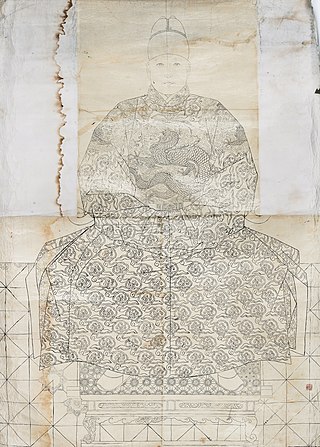Sejong, personal name Yi Do, commonly known as Sejong the Great, was the fourth monarch of the Joseon dynasty of Korea. He is regarded as one of the greatest rulers in Korean history, and is remembered as the inventor of Hangul, the native alphabet of the Korean language.
Seong Sam-mun was a scholar-official of early Joseon who rose to prominence in the court of King Sejong the Great. He was executed after being implicated in a plot to dethrone King Sejo and restore his predecessor King Danjong, and is known as one of the sayuksin with reference to this plot.

Danjong, personal name Yi Hong-wi, was the sixth monarch of the Joseon dynasty of Korea. He was forced to abdicate by his uncle, Grand Prince Suyang, and was put to death after being exiled to Yeongwol.

Sejo, personal name Yi Yu, sometimes known as Grand Prince Suyang, was the seventh monarch of the Joseon dynasty of Korea. He was the second son of Sejong the Great and the uncle of King Danjong, against whom he led a coup d'état in 1453.

Goryeosa, or History of Goryeo, is an extensive historical record of the Goryeo dynasty, compiled by the officials of Goryeo's successor state, Joseon. Its compilation started during the reign of Taejo, was completed under Munjong, and was first printed under Danjong. Goryeosa consists of 139 volumes and stylistically follows Chinese historiography where sections are organized by their purpose. The section compiling the annals of the kings, sega narrates the history of Goryeo kings. The monograph section, ji, contains "accounts of the politics, economics, personnel, geography, astronomy, and other topics related to Goryeo society." The biographies section, yeoljeon, describes notable officials. The chronology section, yeonpyo lists the names of kings and their reigns. The listing section, mongnok, is the table of contents of the entire compilation.

The Hall of Worthies, or Jiphyeonjeon, was a Korean royal research institute during the Joseon period. It was founded by King Sejong the Great in March 1420, and disbanded in June 1456.
Park Paeng-nyeon was a scholar-official of the early Joseon Dynasty, and is known as one of the six martyred ministers. He was born to a yangban family of the Suncheon Park clan, and was the son of high minister Park Jeong-rim. He passed the lower national service examination at a royal visitation in 1434, and was later appointed to the Hall of Worthies by Sejong. In the 1440s, he participated with other members of the Hall of Worthies in the creation of the Hunminjeongeum and the creation of the Hangul alphabet. He passed the higher literary examination in 1447, and rose to vice-minister of justice under Danjong in 1454. He was an 8th cousin of Park Won-jong, the maternal uncle of Yun Im and Queen Janggyeong, the second wife of King Jungjong.
Ha Wiji (1387–1456) was a scholar-official of the early Joseon Dynasty, and is remembered as one of the six martyred ministers. He was born to a yangban family of the Jinju Ha lineage. He passed the lower national service examination in 1435 and received the top score on the higher examination in 1438. He was appointed to the Hall of Worthies by Sejong, and became the leader (gyori) of that institution in 1442. He participated in the editing of histories and other texts.
Yi Gae was a scholar-official of the Joseon period who came from the yangban family Hansan Yi clan and one of the six martyred ministers. He was the great-grandson of Goryeo period philosopher Yi Saek and third cousin of Yi San-hae.
Yu Seong-won was a scholar-official of the early Joseon Dynasty, who is remembered as one of the six murdered ministers. He was born to a yangban family of the Munhwa Ryu lineage, but his date of birth is not known.
Gim Jil, also often spelled Kim Chil, was a scholar-official of the early Joseon Dynasty. He is remembered today primarily for his participation in, and betrayal of, the conspiracy led by the six martyred ministers.
Shim On was a Korean politician. He was the Chief State Councillor of the Korean Joseon from September 1418 to December 1418 and the father of Queen Soheon and father-in-law to King Sejong. He is known for his treason charges, which eventually led to his death and further strengthening of the royal power.
This article explains the history of the Joseon dynasty, which ruled Korea from 1392 to 1897.
Grand Prince Yangnyeong was the former Crown Prince of the Korean Joseon Dynasty. He was the first son of King Taejong and his wife, Queen Wongyeong. Yangnyeong was the elder brother of Sejong the Great, and an ancestor of Syngman Rhee, an independence activist and the first President of South Korea.
Geumo Sinhwa is a collection of novellas, written in Chinese characters by a Korean author Kim Si-seup. Like most of the early literature of Korea it forms part of the Chinese-language literature of Korea.
Princess Gyeonghye, also known before as Princess Pyeongchang before her marriage, was a Joseon princess and the eldest child of Munjong of Joseon. She served as guardian for her only younger brother, Danjong of Joseon, when he ascended the throne underage.
Royal Consort Suk-ui of the Sangsan Kim clan was a Korean royal consort of Danjong of Joseon.
Prince Gyeongnyeong was a Royal Prince of the Joseon period as the fourth son of King Taejong and his concubine, Royal Noble Consort Hyo of the Cheongpung Kim clan.
Prince Hwaui Korean: 화의군; 5 September 1425 – 1460), personal name Yi Yeong 이영), was a prince of the Joseon period of Korea. He was the sixth son of Sejong the Great and younger brother of Munjong of Joseon and Sejo of Joseon.
Yi Jeung, formally known as Prince Gyeyang (계양군), was the eighth son of Sejong the Great born by Royal Noble Consort Shin. Among his father's sons, he was the most favoured, along with his young half-brother, Prince Yeongeung.